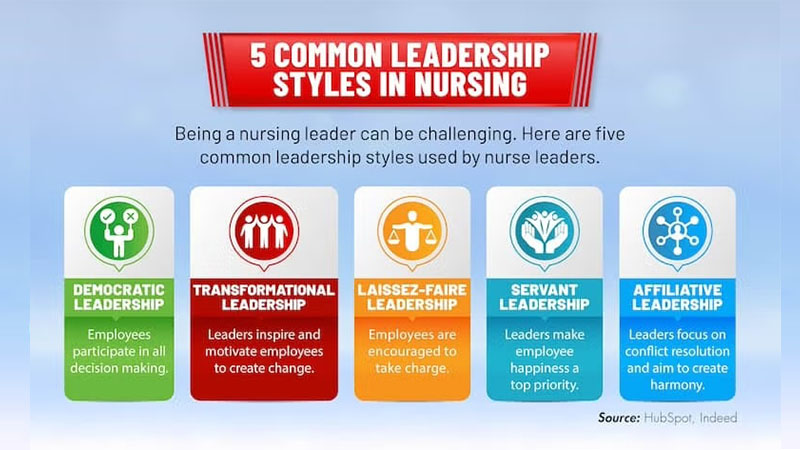10 nurse leadership styles for developing your team

In an increasingly technological nursing environment, nursing leadership has never been more complex or rewarding. With more paths available to become a nursing leader and more ways to lead than ever before, leadership roles are in some way more inevitable and desirable for nurses interested in advancing their careers.
Nurse leaders have different skills and effective leadership in nursing can take many forms. Additionally, nurses can employ many different leadership styles, including servant leadership, democratic leadership and transformational leadership. Whatever style nurses choose, the benefits of effective leadership are clear, such as improved productivity and morale and the ability to succeed under pressure.
However, not all nurse leadership styles work for every situation, nor is every nurse suited for every style. Nurses who understand how to apply the best approach in specific circumstances will have a better chance of standing out among their peers. Those looking to master these styles should consider a postgraduate nursing degree.
What is a nurse leader?
Any nurse who leads, whether it be as an expert in a specific field or as a leader of people, is considered a nurse leader. Nurse leaders can be found at all levels of the healthcare system. They may be clinical or ward leaders, or hold executive or government positions.
Nurse leaders are essential for better patient care and more efficient organisations. Nurses in leadership positions should learn the best possible methods to counter challenges such as an ageing population, rising chronic disease, increasing healthcare costs and the need to improve access to healthcare.
Nurse leaders may or may not lead people, as opposed to nurse managers, who predominantly are responsible for people management. Even if nurse leaders do not specifically have to manage staff, they may still exhibit certain leadership styles in their interactions with colleagues and patients.
The benefits of effective styles of nurse leadership include a more empowered workforce, better organisation, lower attrition rates and higher workforce morale. But for nursing in particular, the benefits of leadership extend beyond these. Effective nursing leadership is also associated with increased quality and integration of care for patients.
10 leadership styles in nursing
While there are many ways to lead, here are 10 styles that can help nurses decide which methods best suit their strengths as leaders.
- Democratic leadership
- Transformational leadership
- Laissez-faire leadership
- Servant leadership
- Affiliative leadership
- Autocratic leadership
- Coaching leadership
- Transactional leadership
- Situational leadership
- Visionary leadership
Style 1: Democratic leadership
Democratic leaders encourage staff to participate in decisions and are known for open and honest communication. Democratic leaders are natural delegators and empower their teams to be responsible and accountable for their actions. Beyond this, democratic leaders always provide feedback, as they value continuous improvement. They also avoid dwelling on the individual mistakes of their team members.
Democratic leadership advantages and challenges
Perhaps the most important advantage of democratic leadership in nursing is that it makes honesty and accountability real priorities and as such, team members have a high level of trust in their leaders. They are also more likely to understand the bigger picture when it comes to their work and be highly satisfied in their roles.
There are some disadvantages to democratic leadership in nursing, however. It can cause leaders to delay decision making. Also, in some circumstances, it may not be possible to reach a consensus, so team members may feel like the consultation was a waste of time.
Style 2: Transformational leadership
Another style that nurse leaders can apply is transformational leadership. This style is heavily focused on building relationships with staff, motivating team members and enabling them to buy into a shared vision and mission. Typically, transformational leaders are charismatic, confident and inspirational. Staff members are usually loyal to transformational leaders and look up to them.
Transformational leadership advantages and challenges
Transformational leadership can be very beneficial in several ways. First, employees feel united around the common purpose of the nursing unit. In addition, there is generally less staff attrition under transformational leaders. Transformational nurse leaders can also manage change effectively.
Like any nursing leadership style, there are downsides to transformational leadership. Transformational leaders can be known to be risky and disruptive, and employees under transformational leaders may burn out quickly.
Style 3: Laissez-faire leadership
Laissez-faire leaders provide very little direction to the nurses on their teams and instead empower them to manage themselves.
Laissez-faire leadership advantages and challenges
This type of leadership can be advantageous for many reasons. With a loose style of management, staff can experience personal growth; when leaders are hands-off, it gives employees room to be hands-on. Related to this, laissez-faire leadership encourages innovation, as employees are free to experiment. With this type of leadership, fast decision making is also possible, as decisions rest wholly with employees.
Laissez-faire leadership in nursing is certainly not ideal for everyone or in every situation. Usually, it is inexperienced leaders or leaders at the end of their careers who use this style, as it is not focussed on problem-solving. When issues do occur, they are solved reactively, which in a clinical situation can be less than ideal.
Style 4: Servant leadership
Servant leadership is exemplified by leaders who influence those around them, building positive working relationships and focussing on developing their teams’ skills. Servant leaders are very attentive to the needs of their teams and are known for listening, committing to team growth and accepting others. They are also persuasive and build a positive sense of community within their teams and healthcare environments.
Servant leadership advantages and challenges
Under servant leadership, team morale is generally high and team members feel their leaders genuinely care about them and their needs. In addition, the collaborative style of decision making increases employee engagement, meaning that nurses will be less likely to leave. Servant leadership is also a strong example of ethical leadership.
On the flip side, this leadership style can have disadvantages. It takes time to build the trust required, and in some situations where nurse leaders need to make quick decisions, it might not work. Furthermore, a team may lose sight of the healthcare organisation’s goals if a leader is too focussed on the staff.
Style 5: Affiliative leadership
Nurse leaders who consider themselves transparent may like to consider the affiliative leadership style. With this style, leaders are completely honest at all times. They are wholly invested in the healthcare setting they work in and the staff who report to them. They become a moral compass for everyone to follow. They are also known for their exceptional communication skills and enjoy giving positive feedback.
Affiliative leadership advantages and challenges
There are many benefits to this style. First, feedback is critical in the workplace, and positive feedback can help employees feel more motivated. Also, under this type of leadership, employees will feel as if they are more highly valued. They will also be less stressed and know that their interests will be considered in all situations.
However, affiliative leaders typically avoid conflict and may struggle to solve complex problems. Also, productivity may decrease under affiliative leaders, as they rely too much on their team’s self-direction to achieve success.

Style 6: Autocratic leadership
Another nursing leadership style is autocratic leadership. This style, however, is quite different from the styles described above.
Autocratic leadership, often used in the past but less popular these days, involves a nurse leader making all decisions about the nursing unit, typically without consulting staff. Autocratic leadership is a command-and-control style, where leaders use negative reinforcement and punishment to ensure compliance with rules. Under this type of leadership, mistakes are not tolerated, and individuals are blamed if they do make them.
Autocratic leadership advantages and challenges
Despite this style of leadership sounding, on the surface, less than ideal, autocratic leadership in nursing does have some benefits. These include effectiveness in emergency or stressful situations in which nurses can find themselves. Quick decisions can be made under this leadership style, which may be required.
This style of leadership also has many downsides. It is inflexible, and employee engagement and motivation may suffer.
Style 7: Coaching leadership
As the name suggests, there is one unique characteristic that nurses who follow this leadership style need: the ability to coach nurses in their teams. Instead of showing direct reports on how to do something, nurses who apply coaching leadership encourage them to try it on their own.
More than this though, coach leaders are known for the exceptional feedback they give. They help nurses see how their work fits into the bigger picture of the healthcare setting and take a personal interest in helping others succeed.
Coaching leadership advantages and challenges
Nurse leaders who follow this style will notice it has many advantages. It produces a positive and uplifting work environment where everyone knows what is expected of them. Nurses under a coach leader also feel confident that they will experience personal and professional growth.
An unwavering focus on coaching alone, however, may not be ideal for every person or every situation. Coaching takes time to be effective, and it may not always be the right approach if there are tight deadlines. Nurse leaders who follow this style must be aware of when it can work, and when their focus must be elsewhere.
Style 8: Transactional leadership
Transactional leaders, also known as managerial leaders, are focussed on controlling and organising their staff and workload. They specialise in short-term planning and reward good behaviour. They also punish poor behaviour. Transactional leaders give nurses clear structures and rules to work within, and give their teams precise directions on what to do.
Transactional leadership advantages and challenges
Structure is almost always essential in nursing, so transactional leadership can have its advantages. Employees, when given a clear set of rules and either a reward or a punishment, understand what is expected of them and are usually productive in achieving goals.
Yet the very structure that can be advantageous for this nursing leadership style can also be a disadvantage. Transactional nurse leaders can be inflexible and too formal in their approach, which may hurt employee morale. Inflexibility on behalf of a nurse leader also does not encourage creativity or out-of-the-box problem-solving.
Style 9: Situational leadership
One advantage for nurse leaders is that they do not need to apply a single leadership style all the time. In fact, they can – and should – use different styles in different situations. This approach is called situational leadership. As the name suggests, it is where nurse leaders adapt their style to suit a situation or work environment.
Nurse leaders who adopt this style are skilled in how they read a work situation and adjust their approach. They are known to excel at giving direction, being flexible, encouraging participation, delegating and being open and honest.
Situational leadership advantages and challenges
Given the flexibility of this style, it has many advantages. These include the ability to react to situations differently and provide the leadership needed at the moment. This leadership style is also comfortable for most employees, as they know their leader will provide them with what they need.
The flexibility of this style, though, is also its downfall. Situational leadership can be confusing to nurses and in different settings, as people never know what to expect. This type of leadership also does not work as well with repetitive tasks.
Style 10: Visionary leadership
Visionary leadership is where a nurse leader provides a compelling vision and a clear and inspiring direction for everyone in the team. Visionary leaders understand the big picture and excel at articulating a long-term path for those around them. Visionary leaders are also great communicators and marketers. People feel inspired by them and like to be around them.
Visionary leadership advantages and challenges
There are many benefits to being a visionary leader. First, nurses who work with visionary leaders understand the goals that everyone is working toward. They are inspired by their leaders’ energy and, as such, are more likely to overcome temporary setbacks. Visionary leaders are also great at acknowledging the achievements of their teams and making them feel valued.
There are disadvantages to this nursing leadership style, however. Visionary leaders place such great emphasis on the future that they can sometimes forget immediate operational concerns. They are leaders of personality more than organisation, so they can also forget to plan and execute important tasks.
Deciding between nurse leadership styles
Given the complexity and challenges involved in nursing, understanding the best leadership style for a team is an important consideration for all nursing leaders. This can depend on many factors.
For nurse leaders, the reality is that different situations will likely require different leadership styles, so a situational leadership style may be most helpful. For example, in emergency and high-pressure situations, a more autocratic style may be required. If the healthcare setting is transforming, which many are doing due to changes in nursing technology, elements of a visionary style could be helpful to inspire nursing staff to embrace the change.
Whatever style is used, nurse leaders must remember that the nurses in their teams will always appreciate input, direction, guidance and the opportunity to learn and grow their careers.
Beyond different situations and settings, another consideration for nurse leaders is the personalities of people in their teams. Working with people who naturally have different personalities will require even more variation in how nurse leaders lead.
Generational differences to leadership styles
Another important consideration for nurse leaders in today’s multigenerational workforce is how different generations respond to different leadership styles, and what each generation expects from its leader. As with different personalities and different situations, the key to managing different generations is to adapt different nursing leadership styles when required.
Baby boomers
Baby boomers are those born between 1946 and 1964. They are usually confident, optimistic, disciplined and independent. Work is very important in their lives, and they enjoy achievement and feel accomplished at work. They are usually very loyal but susceptible to burnout. Baby boomers want leaders who understand what work means to them and who can provide structure, purpose and meaning in their work. They also want leaders who like and respect rules and order.
Generation X
Generation Xers are those born between 1965 and 1980. This generation likes independence and does not respond well to leadership styles that are too controlling, such as an autocratic style. They naturally question leadership and want to work collaboratively with their leaders. They expect results, so they want leaders who will push them to achieve.
Generation Y
Generation Y, also known as the millennial generation, was born between 1981 and 2000. Employees in this generation are team-oriented and want to feel respected by their bosses to make decisions. They do not have the same hierarchical expectations of work as previous generations, so autocratic or transactional leadership styles may provide too much structure for them. They desire to connect with their bosses on a more personal level and may be inspired by visionary leadership.
Generation Z
Generation Zers are those born from 2000 onwards. This generation is known for being financially focussed, entrepreneurial, ethical and morally serious. They speak their minds and expect change and transformation both in their lives and at work. A coaching style is a leading preference for these team-oriented employees, but they also expect to be consulted on key decisions and taken seriously at work despite their age.

Uncover nursing leadership for the future
The nursing environment is becoming more complex as more and more is required of the healthcare system. This presents a challenge for nurse leaders, but also a great opportunity for them to become more flexible with their leadership styles and learn more about their people than ever before.
Nurses, regardless of age, career stage or qualifications, will always be called on to lead in some way. Understanding which nursing leadership styles can work and how to tailor these styles in certain situations can be powerful. It can be the key to growing the potential of the profession and optimising patient care, now and in the future.
Nurses interested in developing different leadership styles should consider JCU’s 100% online Master of Nursing. Those who choose the Leadership and Management specialisation will explore theories of leadership and how to apply them in the health sector.
Find out how a Master of Nursing from JCU can help you become a nurse leader of the future. For more course information, contact an Enrolment Advisor on 1300 535 919.
Find out more about JCU’s online Master of Nursing.
Get in touch with our Enrolment team on 1300 535 919






